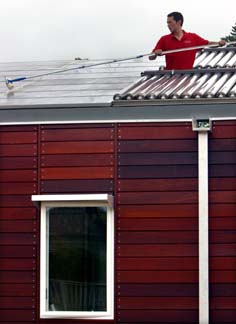On the Washington Mall, Cornell's solar house blooms
By Blaine Friedlander

After Wednesday's judging in the 2005 Solar Decathlon solar-house design contest, the Cornell University team commands third place overall, trailing the leader, the University of Colorado, by 13 points and California Polytechnic State University (Cal Poly) by five. The winner will be announced Oct. 14 at 2 p.m.
There are 18 entries gracing the capital's National Mall for the U.S. Department of Energy's international Solar Decathlon competition. Teams are judged in 10 areas, including architecture, dwelling, documentation, comfort zone, appliances, hot water, lighting, energy balance, communications and documentation. The teams also must provide enough solar energy to power a small car.
In the judging on Oct. 10, Cornell earned 188 out of 200 points in the architecture category, tying with the New York Institute of Technology for third place. Virginia Tech earned the maximum 200 points, and California Polytechnic State University (Cal Poly) earned 192 points.
In the dwelling category, Cornell tied with the University of Colorado with 85 points out of 100 for fifth place. Virginia Tech earned 99 points; Cal Poly, 95; the New York Institute of Technology and the University of Texas tied for third with 92 points; and the University of Pittsburgh, 89 points, fourth place.

After Tuesday's judging, the Cornell team was 27 points behind the leader.
As the home was being prepared for the contest, tourists passed the Cornell solar house and admired the colorful, landscaped garden. Cornell students Lucas Wooster, Marc Miller and Alex Lavallo grew more than 1,500 edible plants -- like peppers, lettuce and herbs -- for the home's landscaping. It took four Penske rental trucks to bring all the plants from Ithaca. The Washington Times newspaper called Cornell's landscape the best garden in the Solar Decathlon.
Blue skies predominated during the setting up of the house late last week, then gave way to thickening clouds and rain, bringing havoc to the first two days of the decathlon. More than 2 inches of rain fell on Friday, turning the National Mall from a scenic destination to a quagmire. By the end of the weekend, more than 7 inches of rain had fallen.
Early in the storm, the Cornell team faced another crisis: The roof of the Cornell house began to leak because there was no seal covering the hole created for heated-water tubes. As the heavy rains drenched Washington, rainwater cascaded all over the Cornell home's electric, computerized control panel.
In the heavy rain, team members climbed on the roof and whisked away water with brooms, while others made makeshift seals that they stabilized with caulk. The team waited five hours for the home's systems panel to dry out before turning the electricity back on.
On Saturday, Carolyn DeWilde Casswell '90, senior associate director of Cornell's Middle Atlantic Alumni Office, organized a decathlon celebration for alumni at the Ronald Reagan Building's rotunda. Members of the Cornell team presented its history to the alumni.
Zellman Warhaft, Cornell professor of engineering, also spoke in the packed rotunda. "In my 25 years on the faculty, this is one of the most thrilling projects I've ever seen," he said. "This group is a wonderful diversity of gender and ethnicity."
Warhaft praised the Cornell house by saying, "It has modernity, but it is not absurdly avant-garde. The other [17] Solar Decathlon teams focused on their own house, while Cornell integrated the landscape into the house's design. The garden is lovely and functional."
Warhaft has been following the project for more than two years and saw the house -- fully assembled -- for the first time on the National Mall. "It struck me how Ithacan it is with its rustic color. All I needed to see were some squirrels and a jar of yogurt," he quipped.
- Number of General Electric 110-watt photovoltaic panels on roof: 56
- Primary post-industrial waste product inside the house's insulation: blue jeans
- Number of feet of polyvinyl chloride pipes used: 0
- Number of evacuated tubes for processing hot water: 32
- Board feet of Brazilian redwood used to clad the house: 3,000
- Wattage used by refrigerator in average home: 800
- Wattage used by refrigerator in Cornell solar home: 250
- Wattage used by light bulb in traditional house: 75
- Wattage used by light bulb in Cornell house: 24
- Estimated cost of the model home built by the University of Michigan: Over $1 million
- Estimated cost of the model home built by Virginia Tech: Over $1 million
- Estimated cost of this Cornell model house: $400,000
- Estimated cost of subsequent basic Cornell models: $70,000
Media Contact
Get Cornell news delivered right to your inbox.
Subscribe